Resources and Facilities
RIKEN centers provide high-quality, high-performance equipment and world-class experimental facilities enabling research at the forefront of science and technology, both for researchers within RIKEN and to collaborators from around the world.
In addition, we have a number of resources that contribute to research carried out by scientists around the globe.
Services
Provision of Bioresources

The RIKEN BioResource Research Center (BRC®) collects five types of bioresources essential for life sciences research at the largest scale worldwide. These resources are propagated and maintained in a safe and high-quality state, and provided to researchers in Japan and abroad.
- (1) Experimental animals: Mouse strains
- (2) Experimental plants: Brachypodium distachyon, Arabidopsis thaliana
- (3) Cellular materials: Human- and animal-derived cancer cells, iPS cells
- (4) Genetic materials: Human- and animal-derived DNA, etc.
- (5) Microbial materials: Microorganisms that contribute to health and the environment
Development of Genetically Engineered Animals
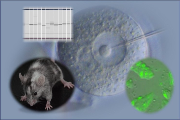
Joint development of genetically engineered animals (mice/rats) with universities and research institutions. The BDR Laboratory for Animal Resources and Genetic Engineering handles the generation of genetically engineered animals using various technologies such as random transgenesis, gene targeting, and genome editing. After publication, the animal resources are widely shared with the research community through the RIKEN BioResource Center (BRC®).
- Read more (in Japanese)
Publication of Program Codes

The Center for Advanced Intelligence Project (AIP) develops new machine learning algorithms. Program codes used in AIP’s published papers are made publicly available for the benefit of researchers in Japan and abroad.
Databases

This database portal site is used to provide information on RIKEN's various life science databases to order to help researchers around the world make full use of RIKEN's research results.
Facilities
The Supercomputer Fugaku

Fugaku, jointly developed by RIKEN and Fujitsu Limited, become available for shared use in March 2021 to provide its computational resources to a wide variety of academic and industrial fields. To make it easier to use Fugaku, the “First-Touch Option” was also added in January 2022. After submitting a simple application through the website, you can start to use Fugaku in as little as one week’s time.
SPring-8 Synchrotron Facility

The ultra-brilliant synchrotron radiation of SPring-8, the world's largest synchrotron radiation facility, offers researchers exciting opportunities for advanced research in life science, materials science, spectroscopic analysis, earth science, environmental science, industrial applications, and other areas.
SACLA X-ray Free Electron Laser Facility
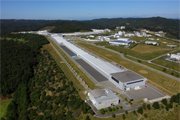
This x-ray free electron laser, one of the most advanced in the world, can take snapshots of ultra-high-speed phenomena, such as chemical reactions, at the atomic and molecular level. This facility is contributing to the realization of a sustainable society, by, for example, elucidating the role of catalysts in photosynthesis. An industrial use promotion programs also being implemented to accelerate companies’ investigative research.
RI Beam Factory

The RIBF, one of the world’s most powerful ion beam factories, makes possible a wide range of experiments and research using high-energy beams, from 1-135MeV/nucleus, from hydrogen to uranium, and can be used to produce radionuclides with half-lives ranging from milliseconds to years. It consists of the world's first superconducting ring cyclotron (SRC) and superconducting RI beam separation (BigRIPS) in addition to the linear accelerator (RILAC) and the AVF cyclotron.
In the facility is used for the development of selective breeding techniques for plants and microorganisms using beam irradiation, and the manufacturing and supply of RI (radioactive isotopes) for cancer treatment. It can also be used for experiments testing the resistance of semiconductors and other devices to radiation, as high-energy beam irradiation can be done at atmospheric pressures.
- Research Use
- Semiconductor radiation resistance test (in Japanese)
NMR Facility

Researchers can use RIKEN's nuclear magnetic resonance (NMR) facilities and the services, such as sample preparation and determination of protein structure, offered as part of the NMR Structural Analysis Pipeline. Solution-NMR or Solid-state NMR is available.
- Read more (in Japanese)
Cryo-Electron Microscopes
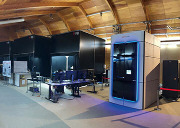
RIKEN has several cryo-electron microscopy systems available for capturing the three-dimensional structures of biomolecular complexes in high resolution.
- Read more (in Japanese)
Special-Purpose Computer for Molecular Dynamics Simulations
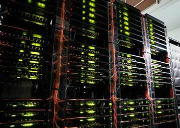
The MDGRAPE computer series are specialized for simulating movements of molecules within cells. RIKEN is advancing the use of this technology for drug discovery and design.
Genomic Analysis
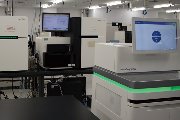
Using the comprehensive data on biological phenomena gathered based on the technology of the life science accelerator (LSA), a technological support system has been developed to accelerate research. RIKEN's pipeline of original technologies is being used to support life science research from the creation of libraries to processing information.
- Read more (in Japanese)
Hormone and Metabolome Analysis

The diverse high-performance mass spectrometers and advanced analytic technologies available at the RIKEN Center for Sustainable Resource Science on the Yokohama Campus support the analysis of hormones and metabolomes. Metabolomic analysis is carried out using multiple mass spectrometers that operate on different principles, which allow high precision wide target and non-target analysis of metabolites with different properties. Highly precise high throughput dynamic analysis of hormones is also possible with ultra-sensitive or high-mass resolution mass spectrometers.
Microscopy/Microscope Analysis

Using the large-scale microscope and imaging facility located at the RIKEN Center for Sustainable Resource Science at the Yokohama Campus, RIKEN offers research support in all areas of microscope technology. Outfitted with a wide variety of equipment such as the latest electron and optical microscopes and sample preparation equipment, this facility offers techniques and apparatuses suited to the samples being observed and the relevant research aims.
NPDepo

The RIKEN Natural Products Depository (NPDepo) has developed a chemical library which is provided to researchers in a wide range of research fields. The chemical library is mainly composed of microbial secondary metabolites and their derivatives, with approximately 93,000 substances included. We also provide a chemical array screening platform to explore small molecule ligands which bind with proteins as well as support for the creation of compound beads used for the identification of target proteins for compounds.
Support for the Development of Hardware for Quantum Computers

The RIKEN Center for Quantum Computing has a variety of research equipment for superconducting quantum computers. Part of this equipment is designated for common use, meaning that those outside of RIKEN working on research and development related to superconducting quantum computers may also use it. Through common use, we are contributing to the improvement of research skills, especially for junior researchers, and to strengthening industrial competitiveness. This facility was established thanks to funding from MEXT.
- Read more (in Japanese)
Library
Users outside of RIKEN who have an invitation letter from a public or university library can make use of RIKEN's library.
